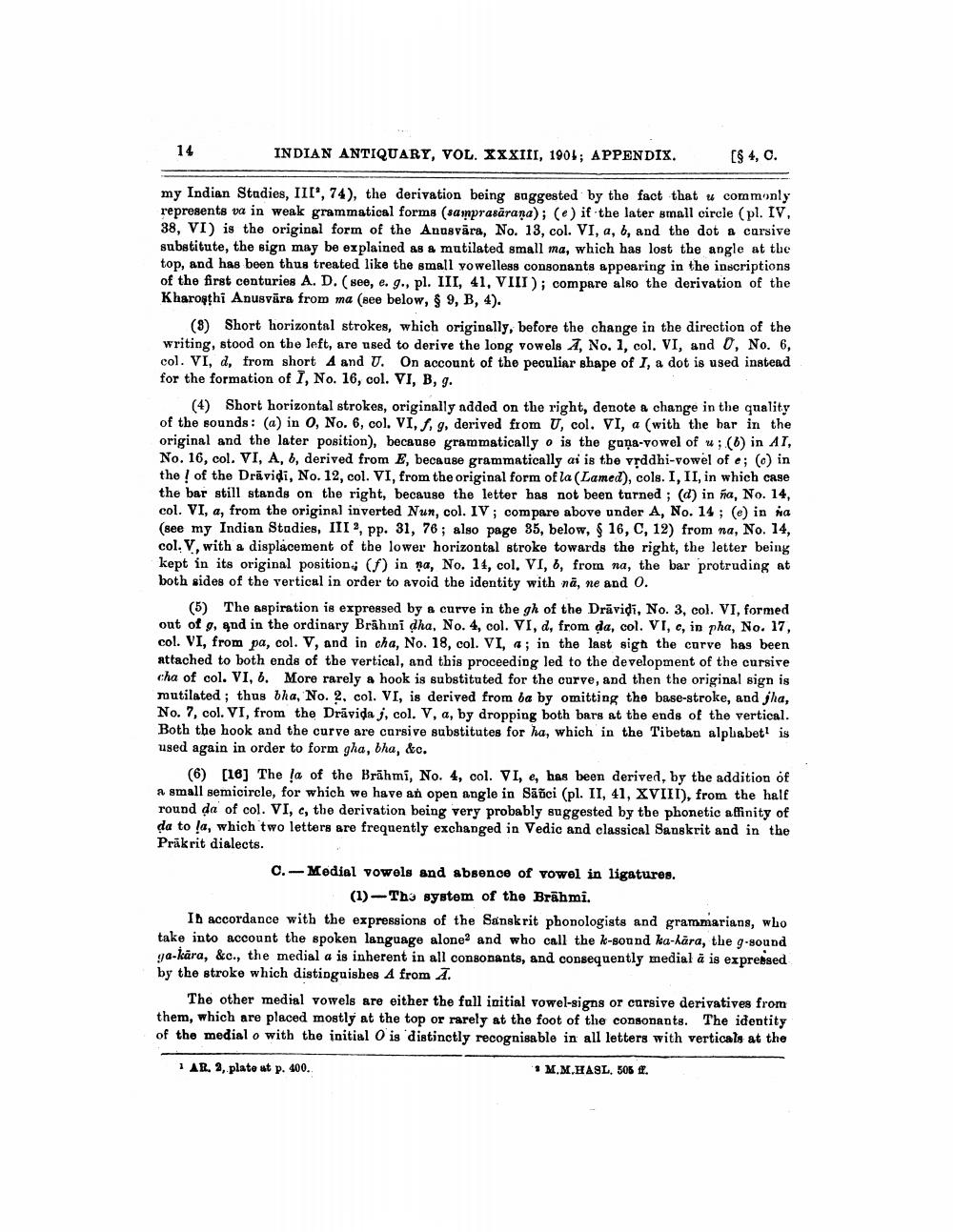________________
14
INDIAN ANTIQUARY, VOL. XXXIII, 1904; APPENDIX.
($ 4, C.
my Indian Stadies, III', 74), the derivation being suggested by the fact that u commonly represents va in weak grammatical forms (samprasarana); (e) if the later small circle (pl. IV, 38, VI) is the original form of the Angsvāra, No. 13, col. VI, a, b, and the dot a carsive substitute, the sign may be explained as a mutilated small ma, which has lost the angle at the top, and has been thus treated like the small yowelless consonants appearing in the inscriptions of the first centuries A. D. (see, e.g., pl. III, 41, VIII ); compare also the derivation of the Kharowthi Anusvāra from ma (see below, $ 9, B, 4).
(3) Short horizontal strokes, which originally, before the change in the direction of the writing, stood on the left, are used to derive the long vowels 7, No. 1, col. VI, and 0, No. 6, col. VI, d, from short A and U. On account of the peculiar shape of I, a dot is used instead for the formation of I, No. 16, col. VI, B, 9.
(4) Short horizontal strokes, originally added on the right, denote a change in the quality of the sounds: (a) in 0, No. 6, col. VI, J, g, derived from U, col. VI, a (with the bar in the original and the later position), because grammatically o is the gaña-vowel of ; (6) in A1, No. 16, col. VI, A, b, derived from E, because grammatically ai is the vddhi-vowel of e; (e) in the ! of the Dravidi, No. 12, col. VI, from the original form of la (Lamed), cols. I, II, in which case the bar still stands on the right, because the letter has not been turned ; (d) in fa, No. 14, col. VI, a, from the original inverted Nun, col. IV; compare above under A, No. 14 ; (e) in na (see my Indian Studies, III, pp. 31, 76; also page 35, below, $ 16, C, 12) from na, No. 14, col. V, with a displacement of the lower horizontal stroke towards the right, the letter being kept in its original position(f) in na, No. 14, col. VI, 6, from na, the bar protruding at both sides of the vertical in order to avoid the identity with nă, ne and O.
(5) The aspiration is expressed by a curve in the gh of the Drāvidi, No. 3, col. VI, formed out of y, and in the ordinary Brähuni dha, No. 4, col. VI, d, from da, col. VI, c, in pha, No. 17, col. VI, from pa, col. V, and in cha, No. 18, col. VI, a; in the last sigh the curve has been attached to both ends of the vertical, and this proceeding led to the development of the cursire cha of col. VI, 6. More rarely a hook is substituted for the curve, and then the original sign is mutilated ; thus bha, No. 2, col. VI, is derived from ba by omitting the base-stroke, and jha, No. 7, col. VI, from the Drāvida j, col. V, a, by dropping both bars at the ends of the vertical. Both the hook and the curve are cursive substitutes for ha, which in the Tibetan alphabeti is used again in order to form gha, bha, &c.
(6) [16] The !a of the Brāhmi, No. 4, col. VI, e, has been derived, by the addition of a small semicircle, for which we have an open angle in Sāõci (pl. II, 41, XVIII), from the half round da of col. VI, C, the derivation being very probably suggested by the phonetic affinity of da to la, which two letters are frequently exchanged in Vedic and classical Sanskrit and in the Prakrit dialects.
0.-Medial vowels and absence of vowel in ligatures.
(1)-Thy system of the Brāhmi. In accordance with the expressions of the Sanskrit phonologists and grammarians, who take into account the spoken language alone and who call the k-sound ka-hara, the g-sound ya-kära, &c., the medial a is inherent in all consonants, and consequently medial à is expressed by the stroke which distinguishes A from A.
The other medial vowels are either the full initial vowel-signs or cursive derivatives from them, which are placed mostly at the top or rarely at the foot of the consonants. The identity of the medial o with the initial O is distinctly recognisable in all letters with verticals at the
1 AR. 2, plato at p. 400.
* M.M.HASL, 505 .




